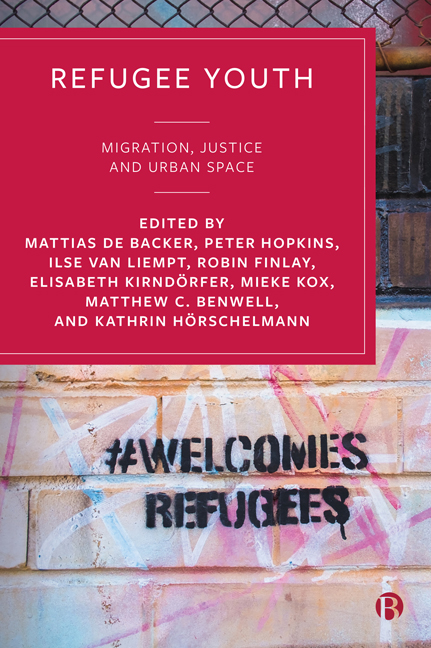Book contents
- Frontmatter
- Contents
- List of Figures and Tables
- Notes on Contributors
- Acknowledgements
- 1 Introducing Refugee Youth: Migration, Justice and Urban Space
- 2 Storying Belonging, Enacting Citizenship? (Dis)articulations of Belonging in a Community Theatre Project with Young Refugees and Asylum Seekers in Leipzig, Germany
- 3 Jackets and Jewellery: Racialised Dispossession and Struggles over Public Space in Denmark
- 4 Venezuelan Refugee Youth and Brazilian Schooling: The Individual between Languages and Spaces
- 5 The Inclusionary Potential and Spatial Boundaries of (Semi-)Public Space: Refugee Youth’s Everyday Experiences in the Urban Fabric of Amsterdam
- 6 Navigating ‘Purdah’ Culture in Urban Space: The Restricted Lives of Young Married Rohingya Refugees in Malaysia
- 7 Inclusive Urban Planning and Public Space for Refugee Youth in Pursuit of a Just City in Amman, Jordan
- 8 Sense of Belonging among Tibetan Refugees in India: A Case Study of the Bylakuppe Settlement in Karnataka, India
- 9 Negotiating Identity in Urban Space: Everyday Geographies of Syrian Students in Istanbul
- 10 ‘You’re Judged a Lot’: Australian Sudanese and South Sudanese Youths’ Perspectives on Their Experiences in Public Spaces
- 11 Hair Salons as ‘Private-Public Spaces’: Exploring the Experiences of Young Migrant Women in an Urban Township in South Africa
- 12 Emotion and Spatial Belonging: Exploring Young Migrant Men’s Emotional Geographies in Cork, Ireland
- 13 Homemaking through Music in Urban Africa: Creating Opportunities as a Refugee and a Migrant in Kinshasa and Dar es Salaam
- 14 Planetary Listening
- 15 Refugee Youth: Politics, Publicness and Visibility
- Index
8 - Sense of Belonging among Tibetan Refugees in India: A Case Study of the Bylakuppe Settlement in Karnataka, India
Published online by Cambridge University Press: 18 January 2024
- Frontmatter
- Contents
- List of Figures and Tables
- Notes on Contributors
- Acknowledgements
- 1 Introducing Refugee Youth: Migration, Justice and Urban Space
- 2 Storying Belonging, Enacting Citizenship? (Dis)articulations of Belonging in a Community Theatre Project with Young Refugees and Asylum Seekers in Leipzig, Germany
- 3 Jackets and Jewellery: Racialised Dispossession and Struggles over Public Space in Denmark
- 4 Venezuelan Refugee Youth and Brazilian Schooling: The Individual between Languages and Spaces
- 5 The Inclusionary Potential and Spatial Boundaries of (Semi-)Public Space: Refugee Youth’s Everyday Experiences in the Urban Fabric of Amsterdam
- 6 Navigating ‘Purdah’ Culture in Urban Space: The Restricted Lives of Young Married Rohingya Refugees in Malaysia
- 7 Inclusive Urban Planning and Public Space for Refugee Youth in Pursuit of a Just City in Amman, Jordan
- 8 Sense of Belonging among Tibetan Refugees in India: A Case Study of the Bylakuppe Settlement in Karnataka, India
- 9 Negotiating Identity in Urban Space: Everyday Geographies of Syrian Students in Istanbul
- 10 ‘You’re Judged a Lot’: Australian Sudanese and South Sudanese Youths’ Perspectives on Their Experiences in Public Spaces
- 11 Hair Salons as ‘Private-Public Spaces’: Exploring the Experiences of Young Migrant Women in an Urban Township in South Africa
- 12 Emotion and Spatial Belonging: Exploring Young Migrant Men’s Emotional Geographies in Cork, Ireland
- 13 Homemaking through Music in Urban Africa: Creating Opportunities as a Refugee and a Migrant in Kinshasa and Dar es Salaam
- 14 Planetary Listening
- 15 Refugee Youth: Politics, Publicness and Visibility
- Index
Summary
Introduction
The Tibetan refugee diaspora has faced protracted displacement since 1959. After the Chinese People's Liberation Army crushed a Tibetan uprising – a result of a decade of coercive Chinese communist state policy and constant human right violations in the Tibet region (Anand, 2003) – an estimated 80,000 Tibetans followed their spiritual leader, the 14th Dalai Lama Tenzin Gyatso, in his flight into India (Dolma, 2019). Consequently, Tibetan refugees were accommodated in refugee settlements all over India and largely still reside there (Smith, 1996; Ahmad, 2012). Both the Tibetan government in exile and the Indian government agreed to keep the Tibetan refugees in settlements isolated from Indian society. The main objective for this was the preservation of the Tibetan culture and to avoid admixture with the local population (Bentz, 2012). Meanwhile, Tibetans largely remain officially stateless, as they are not recognised by the People's Republic of China – currently governing the Tibet region as a part of China – nor have documents of any other country. Tibetans rarely claim Indian citizenship, arguably because of the social pressure from fellow Tibetan refugees and discouragement from the Central Tibetan Administration (CTA). This liminal stage of statelessness has led to lack of career opportunities and ability to integrate and travel abroad (Falcone and Wangchuk, 2008).
In the past five decades, an increasing number of Tibetans have been born in exile. For this generation of Tibetan refugees, the homeland is imagined through oral histories, religion and everyday cultural practices (Falcone and Wangchuk, 2008; Prakash, 2011; Dolma, 2019). The older generation of refugees have continued many of the everyday religious practices of Tibet, such as spinning prayer wheels and hanging prayer flags, during the past decades, whereas most of the youth increasingly characterise themselves as a mix between Tibetan, Indian and Western cultures. Younger Tibetans in exile engage with Indian popular culture such as Bollywood films, which present them with social tensions between old and new ways of viewing certain aspects, such as romance and marriage (Lau, 2010; Swank, 2011). Tibetan youth in many of the settlements are caught between visible and invisible boundaries that exist between Tibetan and anti-Tibetan views (Piltz, 2006). This inherent ambivalence towards a return to Tibet, in addition to constant ‘othering’ by the people outside the settlement, and aspirations to move to Western countries, shapes the often ambiguous, multiple and contested nature of attachment and sense of belonging.
- Type
- Chapter
- Information
- Refugee YouthMigration, Justice and Urban Space, pp. 117 - 138Publisher: Bristol University PressPrint publication year: 2023

